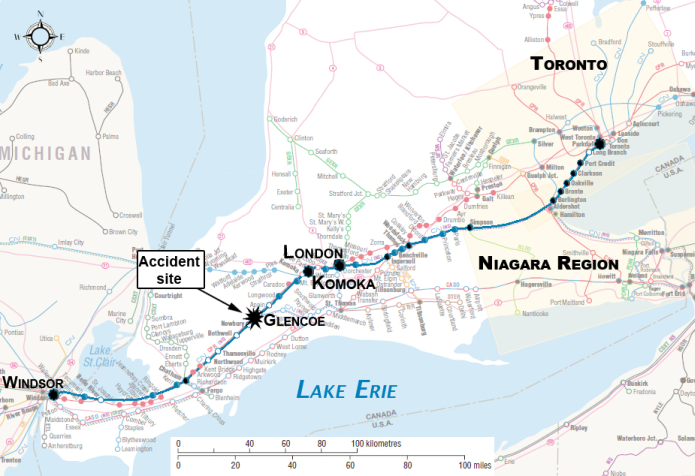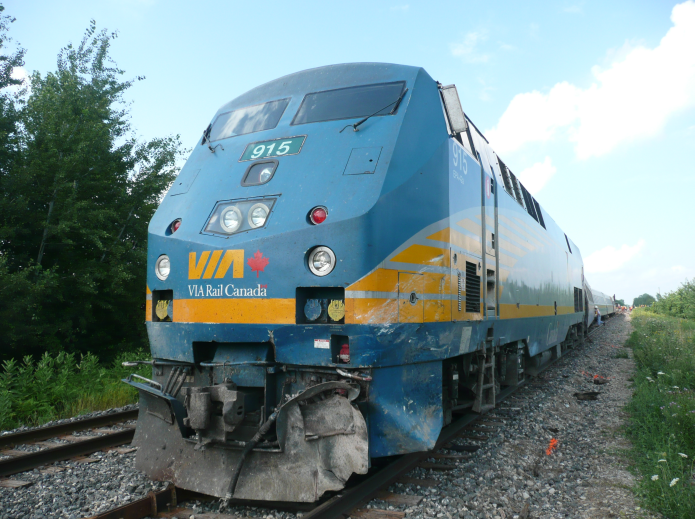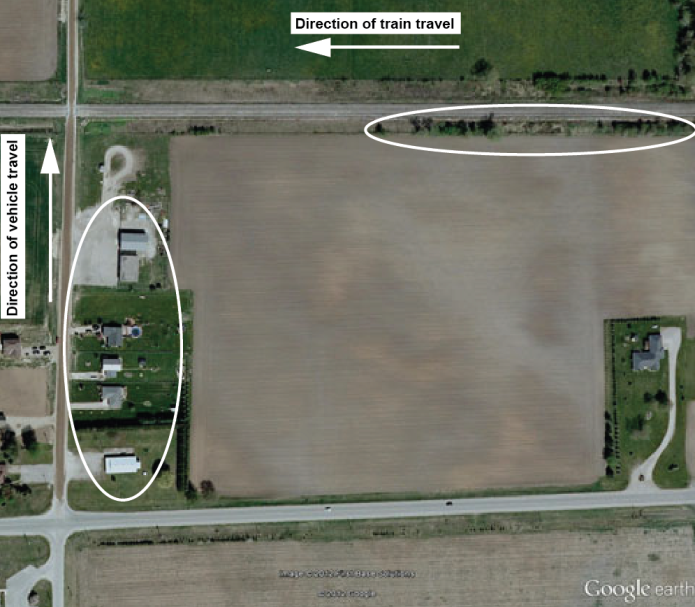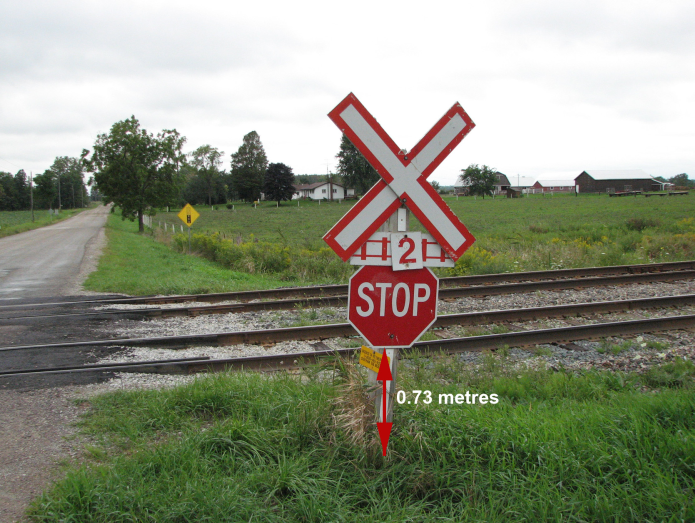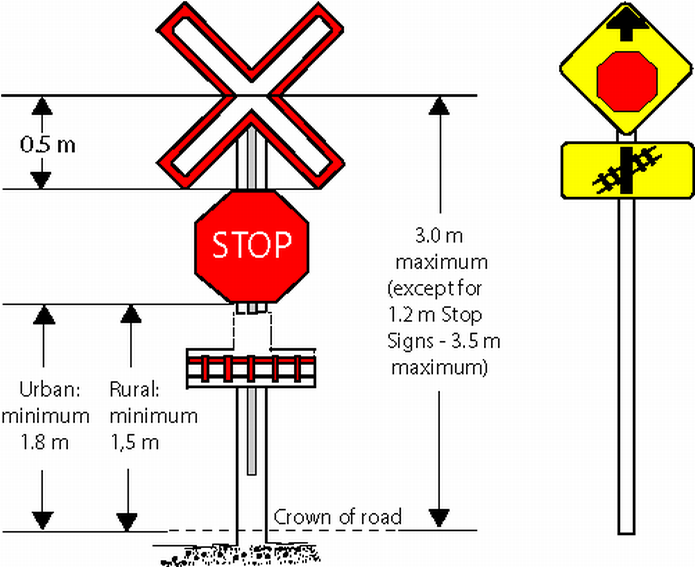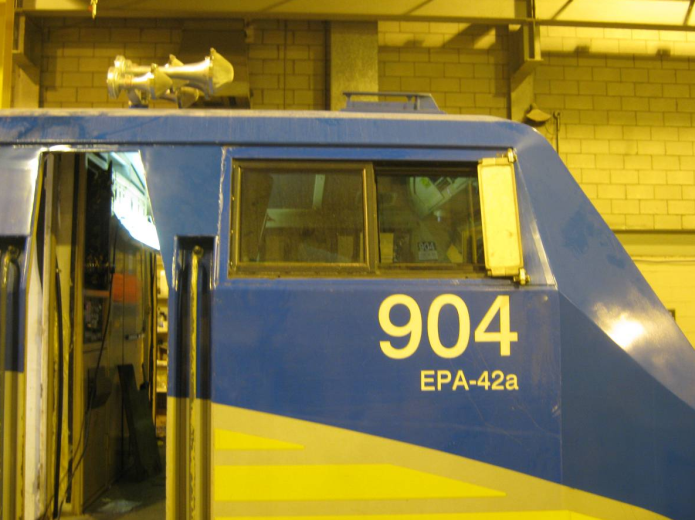Crossing Collision
VIA Rail Canada Inc
Train Number 71
Mile 30.62, Chatham Subdivision
Glencoe, Ontario
The Transportation Safety Board of Canada (TSB) investigated this occurrence for the purpose of advancing transportation safety. It is not the function of the Board to assign fault or determine civil or criminal liability. This report is not created for use in the context of legal, disciplinary or other proceedings. See Ownership and use of content. Masculine pronouns and position titles may be used to signify all genders to comply with the Canadian Transportation Accident Investigation and Safety Board Act (S.C. 1989, c. 3).
Summary
On 29 July 2011, at about 1040 Eastern Daylight Time, VIA Rail Canada Inc. passenger train No. 71, travelling westward at 78 mph on the south main track of Canadian National Railway Company's Chatham Subdivision, struck a pick-up truck on the Pratt Siding Road crossing located at Mile 30.62 near the town of Glencoe, Ontario. The locomotive and all 4 coaches derailed, with some coaches fouling the north main track. The vehicle was destroyed and the lone occupant was airlifted to hospital where he later succumbed to his injuries. Six VIA Rail Canada Inc. passengers had minor injuries.
Ce rapport est également disponible en français.
Factual information
On 29 July 2011, VIA Rail Canada Inc. (VIA) passenger train No. 71 (the train) was en route from Toronto, Ontario, to Windsor, Ontario, on the south main track of the Chatham Subdivision (Figure 1). The train comprised 1 locomotive and 4 coaches; it weighed 312 tons and measured 410 feet in length. There were 116 passengers onboard.
The train crew consisted of an operating locomotive engineer, an in-charge locomotive engineer and a third locomotive engineer who was on board for a refresher training trip after having returned from an extended leave. The crew members were qualified for their respective positions and met established rest and fitness requirements.
At about 1036,Footnote 1 VIA 71 departed Glencoe Station (Mile 27.8) and accelerated up to a speed of about 80 mph. At about Mile 28.0, the train passed eastbound VIA 72, which was stationary on the north track. At about 1040, as the train approached the Pratt Siding Road crossing, the horn was sounded ¼ mile in advance in accordance with regulations. The crew observed a pick-up truck (the vehicle) travelling northward on the road towards the crossing. When it became clear that the vehicle was not slowing down and preparing for a safe stop, the locomotive engineer continuously sounded the whistle and applied the train brakes. The train could not stop before the crossing and struck the vehicle. As a result, the locomotive and all 4 coaches derailed, with some coaches fouling the north main track.
At the time of the accident, the sky was overcast, the temperature was 25°C and the wind was from the west at 12 km/h.
The driver of the vehicle was seriously injured and was airlifted to a hospital in London, Ontario, where he later succumbed to his injuries. Six VIA passengers had minor injuries. Two were taken to hospital and later released, and 4 were treated at the scene. The remaining passengers were transferred to a bus and continued on their voyage.
Site examination
The locomotive and 4 coaches had derailed, but had remained upright, fouling the north main track. The locomotive came to rest about 1135 feet west of the crossing. The north wheels of the leading truck on the locomotive were resting on the web of the north rail. The south wheels were situated between the rails. The locomotive pilot was damaged on the left side, likely when debris from the vehicle lodged underneath (Photo 1).
The vehicle was lying in the south-side ditch approximately 175 feet west of the crossing. Its cab was partially detached from the frame. The engine that had been torn away came to rest about 20 feet east of the vehicle, also in the ditch.
The road surface at the south roadway approach was dry. A 28-foot skid mark, ending at the south rail, was visible on the pavement. Starting at the crossing and extending westward, the north rail of the south track was rolled over. The base and the web of the north rail, approximately 25 feet west of the crossing, presented wheel flange marks. Similar marks were also present on a south rail tie plate, between the rails. There were 2 marks, approximately 12 feet long, on the running surface of the south rail leading up to, and ending at, the gauge side of the rail near the marks on the tie plate. From this point and extending westward for about 650 feet, wheel flange marks were also present on the ties between the rails. Further west, the track was destroyed for another 450 feet.
The Pratt Siding Road crossing
Pratt Siding Road intersects the double main track at a 90° angle. The gravel road had a posted speed limit of 50 km/h and was paved in the vicinity of the crossing. There were a number of road signs on each crossing approach, including a standard reflectorized crossing sign (SRCS), a stop sign,Footnote 2 a number of tracks sign and a railway crossing ahead sign. There was no stop line on either crossing approach.
The SRCS and stop sign were visible from at least 1000 feet for both northbound and southbound vehicles. The track towards the east was concealed to northbound vehicles by buildings adjacent to the road and by vegetation along the track and in the fields (Photo 2). The sightlines at the stop sign of the south crossing approach were more than 2500 feet.
The lower edge of the stop sign was approximately 2.4 feet (0.73 m) from the ground. The sign post was slightly angled to the east. The sign indicating 2 tracks, which was situated under the SRCS, overlapped slightly onto the stop sign (Photo 3).
Canadian National Railway Company (CN) had inspected the crossing on 06 November 2007, 07 April 2009 and 25 January 2011. During the 2007 and 2009 inspections, it had been noted that the south approach crossing signs were in good condition, but were situated too low. This condition was not mentioned in the 2011 inspection report. Based on the Transport Canada (TC) Integrated Risk Information System (IRIS) database, the crossing was last inspected on 03 May 2007. In the IRIS database, the road traffic volume was recorded as 58 vehicles per day.
The Transportation Safety Board (TSB) conducted a series of traffic count surveys at the crossing on 4 separate dates between 11 August 2011 and 24 October 2011 (Table 1). The survey results were used by the Ontario Ministry of Transportation to determine that the average annual daily traffic (AADT) was between 200 and 300 vehicles per day. No detailed crossing assessment had been performed in the 6 years prior to the occurrence.
At this crossing, there had been a previous accident in 1998 (R98S0124). In that occurrence, a VIA train struck a vehicle, fatally injuring its driver.
| Vehicle Type | Date and time | |||
|---|---|---|---|---|
| 11-Aug-11 | 12-Aug-11 | 8-Sep-11 | 24-Oct-11 | |
| 15:00 - 17:00 | 07:00 - 09:00 | 10:15 - 12:15 14:50 - 15:50 |
13:50 to 15:30 | |
| No. of vehicles | No. of vehicles | No. of vehicles | No. of vehicles | |
| Car/Van/SUV | 33 | 31 | 6 | 12 |
| Pick-up Truck/Truck | 10 | 9 | 15 | 7 |
| Tractor Trailer | 2 | 1 | 0 | 0 |
| Motorcycle | 1 | 1 | 0 | 0 |
| Farm Equip. | 1 | 1 | 2 | 0 |
| Other | 0 | 0 | 4 | 1 |
The vehicle driver
The vehicle driver was a local resident and had lived nearby for most of his life and had used this crossing previously. He had been involved in a previous vehicle accident at the Canadian Pacific Railway (CP) crossing located approximately 2 km north of the Pratt Siding Road crossing. On 21 November 2008, the vehicle driver had driven his vehicle into the roadside ditch to avoid a collision with an approaching CP train. A SRCS and a railway crossing ahead sign were installed at the CP crossing.
Subdivision and track information
The Chatham Subdivision extends from Mile 7.1 (Komoka, Ontario) to Mile 104.5 (Windsor, Ontario). VIA owns the portion of track between Mile 63.86 and 99.14, while CN owns the other portions of track. The majority of the subdivision consists of a single main track. However, there are 2 sections of double main track, Mile 27.79 to Mile 32.10 near Glencoe, and Mile 45.01 to Mile 60.61. Train movements on this subdivision are controlled by the Centralized Traffic Control System, as authorized by the Canadian Rail Operating Rules (CROR).
In the vicinity of the accident, the Chatham Subdivision is tangent double main track and is oriented in an east/west direction. The south track is Class 4 track according to the Railway Track Safety Rules and has a maximum allowable speed of 80 mph for passenger trains and 60 mph for freight trains. The north track is Class 3 track and has a maximum allowable speed of 60 mph for passenger trains and 40 mph for freight trains.
At the time of the occurrence, rail traffic on this subdivision consisted of 8 VIA passenger trains and 2 CN freight trains per day. VIA operated 4 eastbound trains and 4 westbound trains between Windsor and Toronto. There was normally a meet between VIA trains at Glencoe twice per day, at 1020 and 1500.
The rail on the south main track was Dominion 115-pound RE continuous welded rail manufactured in 1964 and laid on 11-inch double-shouldered tie plates secured to hardwood ties with 2 or 3 spikes and box anchored every other tie. Near the crossing, the rail was box– anchored every tie. The ties were in good condition. The ballast was crushed rock. The cribs were full and the shoulders were at least 18 inches. The track had been inspected in accordance with company and regulatory requirements. The last track geometry car inspection had taken place on 22 May 2011 and the last visual inspection had taken place on 26 July 2011. No track defects had been noted in the vicinity of the crossing.
Public crossings on the Chatham Subdivision
There are 97 public crossings on the Chatham Subdivision —33 on the portion of track owned by VIA and 64 on the portion owned by CN. All of VIA's crossings have flashing lights, a bell and gates installed. On CN's portions of track, 14 of the 64 crossings are equipped with passive protection (i.e., SRCS and a stop sign). The other 50 crossings are either grade separated or have automatic warning devices (i.e., flashing lights and a bell, with/without gates). Of the 14 passively protected crossings, 4 are in double main track territory where the maximum passenger train speed is 80 mph. Two of these 4 passively protected crossings are located near Glencoe—Pratt Siding Road (Mile 30.62) and Old Airport Road (Mile 29.11). The other 2 crossings are located at Pitt Road (Mile 45.43) and Doherty Street (Mile 52.56).
Close to the Pratt Siding Road crossing is the crossing at Big Bend Road (Mile 32.14). This crossing is situated in single main track territory and is equipped with flashing lights, a bell and gates. Big Bend Road is not paved and has a similar road traffic volume as Pratt Siding Road.
Driver behaviour at crossings
When stop signs are installed at railway crossings, road vehicles must come to a complete stop ahead of the tracks. From a stopped position, drivers are expected to look in both directions to ensure that the way is clear (i.e., no approaching trains) before proceeding.
Through a number of driver behaviour studies, it has been determined that there are varying degrees of driver conformity to a stop sign.Footnote 3, Footnote 4, Footnote 5 While most drivers come to a complete stop and look in both directions (high degree of conformity), some drivers do not reduce their speed and neglect to inspect the intersection for oncoming traffic (low degree of conformity).
A TC reportFootnote 6 into railway crossing accidents cites a studyFootnote 7 indicating that drivers are less likely to comply with stop signs at railway crossings than on highways. Only 60% of drivers stop at railway-highway crossing stop signs compared to 80% at stop signs at highway-highway intersections. The TC report also points out that familiarity with a crossing may encourage drivers to take greater risks. Notwithstanding that collisions at crossings can occur for any type of protection system, the TC report indicates that the conversion from passive crossing protection to active crossing protection can result in a substantial reduction in accidents.
Based on dataFootnote 8 for the 10-year period between 2001 to 2010, the frequency of train-vehicle collisions was determined to be 6 times greater at railway crossings that are equipped only with passive warning systems (i.e., SRCS and/or stop signs) as compared to crossings that are equipped with automated systems (i.e., flashing lights and a bell, with / without gates) (Appendix A).
At the Pratt Siding Road crossing, driver behaviour observations were made on 4 separate dates between 11 August 2011 and 24 October 2011. The results showed that out of 137 drivers:
75 came to a complete stop before proceeding through the crossing, 61 slowed their vehicle to various speeds and then proceeded through the crossing, and 1 driver did not slow at all.
Railway crossing design and signal requirements
TC's draft technical standards, entitled Road/Railway Grade Crossings: Technical Standards and Inspection, Testing and Maintenance Requirements (RTD 10) were issued in 2002. They set out the minimum safety criteria for the construction or alteration, and maintenance (including inspection and testing) of grade crossings and their road approaches. The RTD 10 draft standards were not enforceable, but they were being used as guidelines by TC and the rail industry/road authorities when reviewing safety at grade crossings.
From RTD 10, the sightline distance required at crossings is a function of the type of vehicle for which the crossing is designed, the time it takes the design vehicle to pass completely over the crossing from a stop (departure time), and the maximum train speed. For the Pratt Siding Road crossing, the design vehicle was a WB-20Footnote 9 tractor semi-trailer and the departure time was 13 seconds. Based on these factors, the minimum sightline for the Pratt Siding Road crossing, as recommended by RTD 10, was 1525 feet in each direction.
The RTD 10 guidelines indicated that installation of automatic warning systems at crossings was warranted when there was a forecasted cross-productFootnote 10 of 1000 or more. In addition, gates were warranted when there was a maximum train speed greater than 50 mph or when there were 2 or more tracks where trains may be passing one another.
RTD 10 outlined the design requirements for signs at railway crossings (Figure 2). It also stated that signs and road markings including those at railway crossings must conform to the Manual of Uniform Traffic Control Devices for Canada (MUTCDC). The MUTCDCstates:
- A basic requirement for the effectiveness of signs is to command the respect of road users.
- A high standard of maintenance is essential and well maintained signs have more credibility as traffic control devices.
- Markings on the pavement are a major element in any system of traffic control and one of their functions is to serve as a stop line. The typical installation at a railway crossing where the roadway is paved includes stop lines.
Regulatory safety assessments of crossings
In 2002, TC's proposed “Grade Crossing Regulations” would require road authorities and railway companies to conduct detailed safety assessments at all unrestricted road/railway grade crossings every five years. A detailed safety assessment is a systematic process designed to evaluate the safety of a road/railway grade crossing, and verify compliance to the safety technical standards referred to in the Railway Safety Act, (i.e., Grade Crossing Regulations) and to the guidelines contained in RTD 10. To assist the railway companies and road authorities, TC developed The Canadian Road/Railway Grade Crossing Safety Assessment Guide. This guide was published in April 2005 and provided instructions for conducting safety assessments. It stated that RTD 10 design standards should be referenced during a safety inspection to determine if the conditions warrant upgrading to automatic warning systems and gates. Data such as the daily train volume, AADT, and maximum operating speed for trains were essential to the assessment.
Locomotive horns
Subsection 14(l) of the Canadian Rail Operating Rules stipulates that trains exceeding 44 mph must sound a whistle signal (horn) ¼ mile before a crossing. For trains operating at 80 mph, this would provide 11.25 seconds of auditory warning.
The sounding of the locomotive horn as the train approaches a crossing provides an auditory warning to drivers and pedestrians near or at the crossing. Whistle posts are located approximately ¼ mile in advance of crossings to alert train crews to activate the horn. The effectiveness of the horn as a warning device can be diminished by the attenuation of the sound pressure levels (SPLs). Forward propagating SPLs are reduced with increased distance travelled by the sound waves, increased operating speeds of the locomotive, reduced proximity of the horn to the front of the locomotive, and increased proximity to any obstructions in front of its flutesFootnote 11 such as exhaust vents on the locomotive or nearby buildings and vegetation.
Inside a motor vehicle, the effectiveness of the locomotive horn can be affected by closed windows, engine and road noise (a combination of wheel type and road surface), and radio and fan noise. Nevertheless, some frequencies of the horn sound can still be perceived by the human ear inside a vehicle if these are not masked by other sounds with the same frequencies and higher SPLs.
In February 2010, TC issued the modified Railway Locomotive Inspection and Safety Rules that required the installation of a new horn by 01 January 2012 on locomotives operating in the lead position in passenger service and travelling in excess of 65 mph. The new horn must be capable of generating 2 sound levels: a high-level mode used for emergencies and a lower-level mode used in normal train operations. The horn must be placed near the front of the roof, no more than 5 feet behind the rear of the cab, with no obstructions or exhaust outlets ahead of or beside it.
At the time of the occurrence, the locomotive on VIA 71 had not yet been retrofitted with the new, more powerful, 2-stage horn (Photo 4). Instead, the horn was positioned on the locomotive roof close to the mid-section of the locomotive (Photo 5).
Other related occurrences
Since 2002, the TSB has investigated 6 other crossing accidents where locomotive horn audibility was a factor in the occurrence:
- R10W0123 - At about 0700, Central Daylight Time, on 14 June 2010, Canadian Pacific Railway freight train 290-14 was proceeding southward at 25 mph on the Emerson Subdivision when it was struck by an eastbound garbage truck travelling at a speed of at least 60 km/h, as the train occupied the passive crossing at Mile 13.85, near Grande Pointe, Manitoba. As a result of the collision, 22 car bodies derailed and the fuel tank on the second locomotive was punctured releasing about 4000 gallons of diesel fuel. The driver was seriously injured.
- R09V0219 - On 14 October 2009, at 1514 Pacific Daylight Time, southbound VIA Rail Canada Inc. passenger train 198 struck a vehicle on the Dorman Road level crossing at Mile 75.68 of the Victoria Subdivision. As a result of the collision, two occupants of the vehicle sustained fatal injuries and a third was taken to hospital in serious condition.
- R08M0002 - On 19 January 2008, at approximately 1105 Eastern Standard Time, Chemin de fer de la Matapédia et du Golfe inc. freight train 403, travelling westward on the Mont-Joli Subdivision, struck a northbound minivan at the Highway 291 level crossing in the town of Saint-Arsène, Quebec. Two of the five occupants were fatally injured and a third was critically injured.
- R04H0014 - At 1728 Eastern Daylight Time on 06 October 2004, Canadian Pacific Railway freight train No. 120-03, proceeding eastward at 28 mph on the Ottawa Valley Railway, struck a northbound vehicle at the River Road public crossing, near Castleford, Ontario. The occupant of the vehicle was fatally injured.
- R04H0009 - On 28 June 2004 at 1836 Eastern Daylight Time, VIA Rail Canada Inc. passenger train No. 49, travelling westward at 93 mph, struck an empty 10-ton dump truck at the public crossing at Mile 17.88 of the Smiths Falls Subdivision, near Munster, Ontario. The truck was destroyed, and the occupant was fatally injured.
- R02W0063 - At 1612 Central Daylight Time on 02 May 2002, eastward Canadian National (CN) train E20251–30 derailed 2 locomotives and 21 freight cars after colliding with a loaded southbound tractor-trailer. The collision occurred at a public crossing near Firdale, Manitoba. The derailed equipment included 5 tank cars carrying dangerous goods. During the derailment, four of the tank cars sustained multiple punctures and released their products. The products ignited and a large fire engulfed the derailed cars. A total of 156 people were evacuated from the vicinity of the derailment for 2 days.
Following the investigation into a 1999 accident (R99T0298) involving a CN freight train and a tractor-trailer at a farm crossing at Mile 292.59 of CN's Kingston Subdivision near Bowmanville, Ontario, the Board recommended that:
The Department of Transport expedite the promulgation of new grade crossing regulations.
Transportation Safety Recommendation R01-05
Transport Canada stated that they agreed with the need for the promulgation of the new grade crossing regulations. TC revised the proposed Grade Crossing Regulations and related documents to address stakeholder concerns from past consultations. A further round of external consultation for the proposed regulations (including RTD 10) was scheduled. In February 2012, the Board reassessed TC's response to this recommendation as having Satisfactory Intent.
Following the investigation into a 2007 public crossing accident (R07D0111) involving a VIA train and a tractor-trailer at Mile 23.57 on CN's Kingston Subdivision near Pincourt/Terrasse-Vaudreuil, Quebec, the Board recommended that:
Transport Canada conduct safety assessments of level crossings on the high-speed passenger rail Quebec-Windsor corridor and ensure that defences are adequate to mitigate the risk of truck/train collision.
Transportation Safety Recommendation R09-01
Transport Canada agreed in principle with the recommendation and had indicated its active support through safety programs such as monitoring and funding. However, TC also indicated that it is the responsibility of the rail company and road authority to conduct safety assessments of their grade crossings. In February 2012, the Board reassessed TC's response to this recommendation as having Satisfactory Intent.
Over the past 10 years, there have been 257 accidents involving passenger trains colliding with vehicles at level crossings in Canada. Seventy-one of these occurred in the Quebec City–Windsor corridor, Canada's busiest and most travelled train route. Warning signs at both public and private crossings are the first line of defense to help reduce the risk by making drivers aware of the crossing. Approximately one-third of public crossings in Canada have crossing gates and/or flashing lights and bells.Footnote 12 Despite these warning devices, collisions between vehicles and passenger trains continue to occur.
In March 2010, and again in June 2012, the TSB issued its Watchlist, which included “Passengers Trains Colliding with Vehicles” as a priority safety issue. To address this safety issue, the TSB suggested that Transport Canada implement new grade crossing regulations, develop enhanced standards or guidelines for certain types of crossing signs, and continue its leadership role in crossing safety assessments. The Board also indicated that a comprehensive solution must include further improving public awareness of the dangers at railway crossings.
Analysis
The train had been operated in accordance with regulatory and company procedures. There were no track deficiencies that were found to contribute to the accident. The analysis will focus on the behaviour of the driver at the crossing, the adequacy of the train horns to alert vehicle drivers to the presence of a train, and the level of safety at railway crossings with passive warning devices.
The accident
The stop sign was visible to northbound vehicles and the sightlines at the stop sign met the draft standards as detailed in RTD 10. However, the buildings located along the east side of Pratt Siding Road and the vegetation along the track and in the fields prevented the vehicle driver and the train crew from noticing each other well in advance of the crossing. The vehicle came into view of the train crew only after it passed the buildings. By that time, there were only a few seconds remaining before the train and the vehicle reached the crossing.
As the driver did not stop at the stop sign but applied the brakes just prior to reaching the crossing when he became aware of the oncoming train, the vehicle skidded onto the railway right-of-way and into the path of the train. The train brakes were applied; however, there was insufficient time to avoid the collision. The locomotive struck the passenger side near the front of the vehicle and dislodged the engine from under the vehicle hood. Given the relative mass of the locomotive and the vehicle, it is unlikely that the impact of the collision caused the locomotive to derail. Rather, a piece of the vehicle, which damaged the locomotive pilot, became lodged under the front of the locomotive, leading to the derailment.
Locomotive horn
The locomotive horn was sounded as required when approaching the crossing, and was sounded continuously once the train crew realized that the vehicle was not stopping. These actions may not have alerted the vehicle driver of the approaching train. Several factors affected the efficacy of the horn, including the speed of the train and the placement of the horn on the VIA 71 locomotive. With the train travelling at approximately 80 mph and the horn placed near the mid-point of the locomotive, these factors reduced the forward sound pressure propagation and the resulting auditory warning. In comparison, the more powerful 2-stage horns placed at the head end of the locomotive, as required by the new Railway Locomotive Inspection and Safety Rules, are designed to reduce the negative effects of higher speed and horn placement on forward sound pressure propagation.
In addition, the sound levels inside the vehicle could have been affected by road and engine noise, the operation of the fan and the radio, as well as the positioning of the windows. However, the damaged condition of the vehicle due to the accident precluded any determination of the settings for the fan and the radio and the positioning of the window. Because the in-vehicle sound levels could not be determined, it is unknown whether a retro-fitted horn on the locomotive would have been sufficient to alert the driver in time to avoid the collision.
Driver behaviour at crossings
For northbound vehicles stopped at the crossing, the sightlines complied with RTD 10. The SRCS and stop signs were visible for at least 1000 feet. Consequently, a driver would be able to see the signage from a sufficient distance in order to stop at the crossing and have sufficient sightlines to observe the track to see if it was clear, and then safely travel through the crossing. In this occurrence, the vehicle driver did not comply with the existing signage. The skid marks on the pavement, extending to the south rail, indicate that the brakes were applied suddenly and that the vehicle did not stop prior to entering the crossing.
Advance warning signs and passive warning devices at railway crossings inform vehicle drivers of the presence of a crossing. However, driver compliance to the sign is critical to ensure crossing safety. A certain percentage of vehicle drivers do not always comply with railway crossing signs. This type of driver behaviour was observed during the TSB traffic survey at the Pratt Siding Road crossing and was also identified in a TC report concerning railway crossing accidents.
Familiarity with a particular railway crossing can encourage a driver to take greater risks. Furthermore, when rail traffic volume is low at a crossing, drivers can become desensitized to the risks. For vehicle drivers, who are repeatedly exposed to risk, but do not experience any adverse consequences, situational awareness at railway crossings may transition from a state of high alertness to a more relaxed state over time, increasing the risk that crossing signs will not always be complied with. The vehicle driver in this occurrence had a previous accident at a nearby crossing in 2008. Nevertheless, his vigilance at this crossing may have decreased with time as being exposed to risk with no adverse effects resulted in paying less attention to the source of the risk.
Regulatory and railway safety assessments of crossings
The Pratt Siding Road crossing is located in double main track territory where higher speed VIA trains regularly meet. Crossings with these characteristics present an elevated level of risk to motor vehicles. The risk level is calculated by a formula that considers: number of tracks, the train speed, and the likelihood of a train meet, as well as the train and vehicle traffic. For the Pratt Siding Road crossing, with a cross-product of 2000, TC's draft RTD 10 guidelines suggest the installation of flashing lights, a bell and gates at the crossing.
Prior to the occurrence, CN had regularly inspected the crossing. However, no detailed crossing assessment had been performed. Had an assessment been performed using the proposed draft standards described in RTD 10, vehicle and train traffic volume, train speed, and the possibility for train meets to occur would have been considered and the need for automated warning devices been identified. When detailed crossing assessments are not conducted on a regular basis, some crossings may not be identified for upgraded crossing protection, increasing the risk of a crossing accident, especially on multi-track passenger train corridors.
Railway crossing design and signal requirements
The signage marking the Pratt Siding Road crossing was visible to the approaching drivers and properly informed them of the hazards present. However, some of the signs were not installed at the recommended height and were not well maintained as outlined in the proposed draft standards (Section 9 of RTD 10) and in the MUTCDC. Furthermore, there were no markings on the roadway to indicate where vehicles should stop. Such factors are known to adversely affect the level of compliance accorded to railway crossing signs by vehicle drivers, increasing the risk of a vehicle-train collision.
Findings
Findings as to causes and contributing factors
- The vehicle driver did not stop at the stop sign but applied the brakes just prior to reaching the crossing when he became aware of the oncoming train. The vehicle skidded onto the railway right-of-way and into the path of the train.
- The sightlines at the stop sign were adequate; however buildings along the east side of road and vegetation along the track and in the fields prevented the vehicle driver and the train crew from noticing each other well in advance of the crossing.
- Although the locomotive horn was sounded as required when approaching the crossing, and was sounded continuously when the train crew realized that the vehicle was not stopping, these actions may not have alerted the vehicle driver to the approaching train.
- With the train travelling at approximately 80 mph and the horn placed near the mid-point of the locomotive, the forward sound pressure propagation of the horn and its resulting auditory warning was reduced.
- During the collision, a piece of the vehicle, which damaged the locomotive pilot, became lodged under the front of the locomotive, leading to the derailment.
Finding as to risk
- For vehicle drivers, who are repeatedly exposed to risk, but do not experience any adverse consequences, situational awareness at railway crossings may transition from a state of high alertness to a more relaxed state over time, increasing the risk that crossing signs will not always be complied with.
- Non-standard installation of railway crossing signs and poor sign maintenance practices can adversely affect the level of compliance accorded to railway crossings signs by vehicle drivers, increasing the risk of a vehicle-train collision.
- When detailed crossing assessments are not conducted on a regular basis, some crossings may not be identified for upgraded crossing protection, increasing the risk of a crossing accident, especially on multi-track passenger train corridors.
Safety action
TSB rail safety advisory letter
On 13 December 2011, the TSB issued Rail Safety Advisory Letter (RSA) 12/11 to Transport Canada (TC) indicating the potential risk of accidents at passively protected crossings located in double main track territory owned by Canadian National on the Chatham Subdivision.
On 27 January 2012, TC responded that it had discussed the safety of the crossings located at Pratt Siding Road, Pitt Road, Old Airport Road and Doherty Street with CN.
Regulator and industry
Other regulator and industry safety action includes:
- Operation Lifesaver provided several education and awareness sessions to students at nearby schools about safety at railway crossings.
- CN Police will continue to monitor driver awareness at public crossings in the area.
- The Road Authority performed crossing safety assessments of all crossings in the area.
- TC initiated discussions with the Road Authority to enhance the level of protection at the Pitt Road, Old Airport Road and Doherty Street crossings.
- CN submitted an application for funding under the Grade Crossing Improvement Program (GCIP) to upgrade the Pratt Siding Road crossing protection to flashing lights, bells and gates.
- TC modified its 2002 draft Railway-Roadway Grade Crossings Regulations and its RTD10 (now known as the Canadian Railway-Roadway Grade Crossings Standards) which will be incorporated by reference in the Regulations. The draft Regulations clarified the roles and responsibilities of railway companies and road authorities and focussed on making the grade crossing owners more accountable and proactive in ensuring the safety at crossings. The final round of consultations prior to publishing in the Canada Gazette, Part I was completed on 21 June 2012.
This report concludes the Transportation Safety Board’s investigation into this occurrence. Consequently, the Board authorized the release of this report on . It was officially released on 04 October 2012.
Appendices
Appendix A – Accidents at public crossings involving vehicles on federally regulated track
| Type of crossing protection | Number of crossings | Number of vehicles travelling over crossings annually | Average number of crossing accidents per year (2001 – 2010) |
Accidents per vehicle travelling over a crossing | Relative accident frequency (Passive vs Automated) |
|---|---|---|---|---|---|
| Public Automated | 5,566 | 6,192,037,390 | 111.2 | 1.796 x 10-7 | 1.0 |
| Public passive | 8,637 | 647,933,765 | 70.0 | 1.080 x 10-6 | 6.0 |
